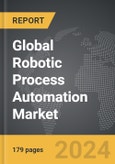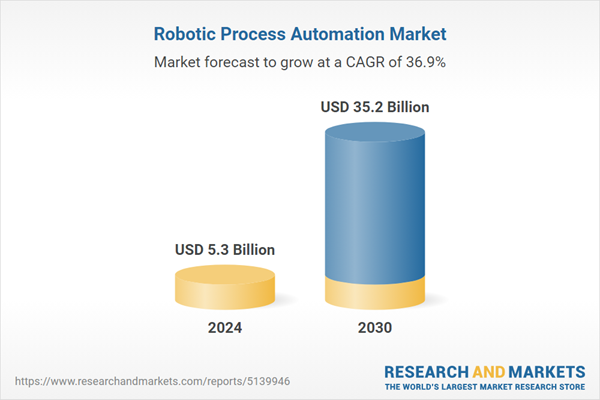Global Robotic Process Automation Market - Key Trends and Drivers Summarized
What Is Robotic Process Automation (RPA) and How Is It Transforming Business Operations?
Robotic Process Automation (RPA) refers to the use of software robots, or 'bots,' to automate repetitive and rule-based tasks in business processes, enabling organizations to improve efficiency, reduce costs, and minimize human error. RPA is widely used across various industries, such as finance, healthcare, insurance, manufacturing, and retail, where tasks like data entry, invoice processing, customer service, and compliance management are common. By mimicking human actions and interacting with digital systems and applications, RPA bots can perform tasks faster and more accurately than human workers, freeing up valuable human resources for more strategic and value-added activities. As organizations increasingly focus on digital transformation, RPA is emerging as a critical tool for optimizing business processes and enhancing competitiveness.How Are Technological Advancements Driving the Robotic Process Automation Market?
Technological advancements are significantly enhancing the capabilities and scalability of Robotic Process Automation, making it more intelligent, flexible, and accessible. The integration of artificial intelligence (AI) and machine learning (ML) is enabling RPA bots to handle more complex tasks that require decision-making, pattern recognition, and natural language understanding. The development of intelligent automation platforms that combine RPA with AI, analytics, and cognitive technologies is enabling end-to-end automation of business processes, further increasing efficiency and reducing operational costs. Additionally, advancements in cloud-based RPA solutions are making automation more scalable and cost-effective, allowing organizations to deploy bots across multiple environments without significant infrastructure investments. The use of low-code and no-code platforms is also democratizing RPA, enabling business users with minimal technical expertise to develop and deploy automation solutions.What Challenges and Opportunities Exist in the Robotic Process Automation Market?
The RPA market faces several challenges, including integration with legacy systems, resistance to change within organizations, and the need for skilled personnel to manage and optimize RPA deployments. Integrating RPA solutions with complex and outdated IT infrastructure can be challenging and requires careful planning and execution. Resistance to change from employees who fear job displacement or lack understanding of RPA benefits can also hinder adoption. However, these challenges present significant opportunities for growth and innovation. The increasing demand for digital transformation and operational efficiency across various sectors is driving the adoption of RPA solutions. The rise of hyperautomation, which involves the combination of RPA, AI, and other advanced technologies, is further expanding the market potential. Moreover, the growing emphasis on compliance, data security, and risk management is creating new opportunities for RPA providers to develop more secure and compliant automation solutions.What Factors Are Driving the Growth of the Robotic Process Automation Market?
The growth in the Robotic Process Automation market is driven by several factors, including the rising demand for operational efficiency, cost reduction, and digital transformation across various industries. Technological advancements in AI, machine learning, cloud computing, and low-code/no-code platforms are enhancing the capabilities, scalability, and accessibility of RPA solutions, driving their adoption. The increasing need for regulatory compliance, data security, and risk management in sectors such as finance, healthcare, and insurance is also contributing to market growth. Additionally, the expansion of hyperautomation and the integration of RPA with AI, analytics, and cognitive technologies are boosting the demand for more intelligent and comprehensive automation solutions. The growing emphasis on improving customer experience, reducing manual errors, and optimizing business processes is further propelling the RPA market forward.Report Scope
The report analyzes the Robotic Process Automation market, presented in terms of market value (USD). The analysis covers the key segments and geographic regions outlined below.- Segments: Type (Services, Software); Deployment (On-Premise, Cloud); Organization Size (Large Enterprises, SMEs); Application (BFSI, IT & Telecom, Logistics, Energy & Utilities, Pharma & Healthcare, Manufacturing, Retail & Consumer Goods, Other Applications).
- Geographic Regions/Countries: World; United States; Canada; Japan; China; Europe (France; Germany; Italy; United Kingdom; and Rest of Europe); Asia-Pacific; Rest of World.
Key Insights:
- Market Growth: Understand the significant growth trajectory of the Robotic Process Automation Services segment, which is expected to reach US$23.3 Billion by 2030 with a CAGR of 37.5%. The Robotic Process Automation Software segment is also set to grow at 35.8% CAGR over the analysis period.
- Regional Analysis: Gain insights into the U.S. market, valued at $1.5 Billion in 2024, and China, forecasted to grow at an impressive 34.9% CAGR to reach $5 Billion by 2030. Discover growth trends in other key regions, including Japan, Canada, Germany, and the Asia-Pacific.
Why You Should Buy This Report:
- Detailed Market Analysis: Access a thorough analysis of the Global Robotic Process Automation Market, covering all major geographic regions and market segments.
- Competitive Insights: Get an overview of the competitive landscape, including the market presence of major players across different geographies.
- Future Trends and Drivers: Understand the key trends and drivers shaping the future of the Global Robotic Process Automation Market.
- Actionable Insights: Benefit from actionable insights that can help you identify new revenue opportunities and make strategic business decisions.
Key Questions Answered:
- How is the Global Robotic Process Automation Market expected to evolve by 2030?
- What are the main drivers and restraints affecting the market?
- Which market segments will grow the most over the forecast period?
- How will market shares for different regions and segments change by 2030?
- Who are the leading players in the market, and what are their prospects?
Report Features:
- Comprehensive Market Data: Independent analysis of annual sales and market forecasts in US$ Million from 2024 to 2030.
- In-Depth Regional Analysis: Detailed insights into key markets, including the U.S., China, Japan, Canada, Europe, Asia-Pacific, Latin America, Middle East, and Africa.
- Company Profiles: Coverage of players such as 1901 Group, ABBYY Emerging Markets (3A), ABBYY North America, Accelirate, Accely Group and more.
- Complimentary Updates: Receive free report updates for one year to keep you informed of the latest market developments.
Some of the 12 companies featured in this Robotic Process Automation market report include:
- 1901 Group
- ABBYY Emerging Markets (3A)
- ABBYY North America
- Accelirate
- Accely Group
- Accord Business Group
- Accubits
- Acronotics
- Aegis Soft Tech
- AgileThought, Inc.
This edition integrates the latest global trade and economic shifts into comprehensive market analysis. Key updates include:
- Tariff and Trade Impact: Insights into global tariff negotiations across 180+ countries, with analysis of supply chain turbulence, sourcing disruptions, and geographic realignment. Special focus on 2025 as a pivotal year for trade tensions, including updated perspectives on the Trump-era tariffs.
- Adjusted Forecasts and Analytics: Revised global and regional market forecasts through 2030, incorporating tariff effects, economic uncertainty, and structural changes in globalization. Includes historical analysis from 2015 to 2023.
- Strategic Market Dynamics: Evaluation of revised market prospects, regional outlooks, and key economic indicators such as population and urbanization trends.
- Innovation & Technology Trends: Latest developments in product and process innovation, emerging technologies, and key industry drivers shaping the competitive landscape.
- Competitive Intelligence: Updated global market share estimates for 2025, competitive positioning of major players (Strong/Active/Niche/Trivial), and refined focus on leading global brands and core players.
- Expert Insight & Commentary: Strategic analysis from economists, trade experts, and domain specialists to contextualize market shifts and identify emerging opportunities.
Table of Contents
Companies Mentioned (Partial List)
A selection of companies mentioned in this report includes, but is not limited to:
- 1901 Group
- ABBYY Emerging Markets (3A)
- ABBYY North America
- Accelirate
- Accely Group
- Accord Business Group
- Accubits
- Acronotics
- Aegis Soft Tech
- AgileThought, Inc.
Table Information
| Report Attribute | Details |
|---|---|
| No. of Pages | 179 |
| Published | December 2025 |
| Forecast Period | 2024 - 2030 |
| Estimated Market Value ( USD | $ 5.3 Billion |
| Forecasted Market Value ( USD | $ 35.2 Billion |
| Compound Annual Growth Rate | 36.9% |
| Regions Covered | Global |









